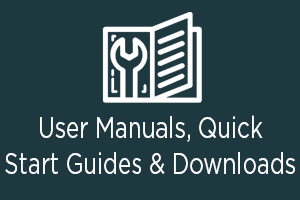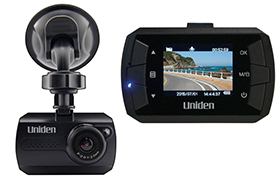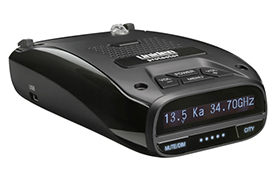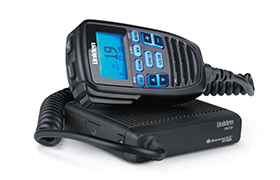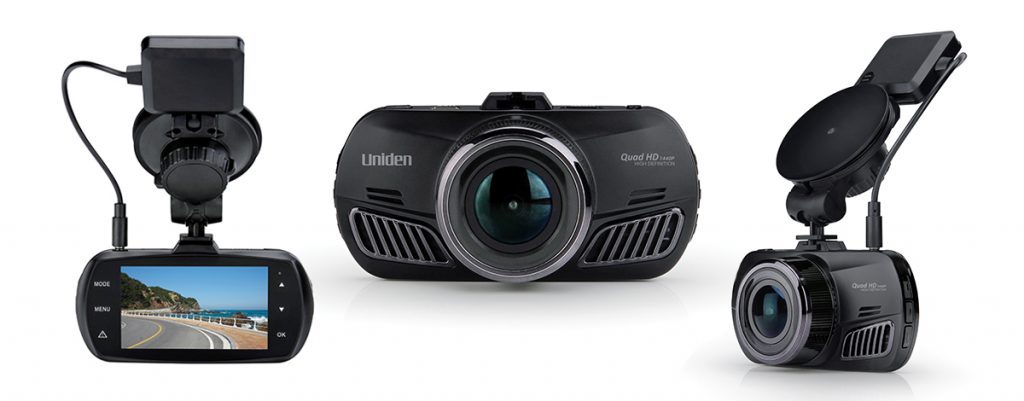
Uniden Dashcams
DC360
- Remove the Micro SD Card from the DC360. Using an SD Card Reader or an adapter, insert the Micro SD card into the reader and then into a computer with internet access.
- Download the firmware data file onto your Micro SD Card.
- Remove the Micro SD Card from the reader.
- Make sure the DC360 is powered OFF.
- Insert the Micro SD into the DC360.
- Power On the Vehicle. The DC360 should Power On (if not, turn the Power On). The install will automatically start. After the opening screen you will see “FW UPDATING….” and the update takes approximately 1 minute. The unit will Power Off once completed.
- Power Off the vehicle and remove the Micro SD Card.
- Using an SD Card Reader or an Adapter, insert the Micro SD card into the reader and then into a computer.
- Find the Removable Disk (SD Card) and Delete the file “hincam.brn”.
- Remove the SD Card from the reader and reinstall into the DC360. Power ON and reset the date and time.
- Firmware update completed and should show version V20190824.01
- Uniden Driving Recorder Player for CAM 650 — [ZIP]
- Uniden Driving Recorder Player for CAM 945 — [ZIP]
Shock Sensor — Shock sensor detects sudden acceleration, breaking or impact, and locks the video file. This automatically protects most important video clips from overwriting when memory card runs out of free space. Also it triggers recording in parking monitoring mode.
Parking Monitoring — If shock sensor detects an impact, it turns the camera on and record short video clip. Then camera turns off again to save battery. This helps if your parked car was hit.
Motion Detection — If enabled, camera only records when it sees something moving. If a picture does not change, then nothing is recorded. This is helpful to conserve the space on the memory card then your car is stationary.
HDMI — This is a digital interface to connect your camera to modern flatscreen TV to see your video in razor sharp Full HD.
AV Out — This is analog interface to connect your camera to older TVs and VCRs.
Driving Aids — Built-in processor can analyze video feed and it can warn the driver as needed. For example, if you forgot to turn on your headlights, or you are following other car too close, it will warn you. If you stopped at intersection, and a car in front you moved, but you did not – it can gently let you know.
Backup Camera — With optional backup camera, you can clearly see what’s behind your car when you are backing up. Backup camera usually mounted right over rear bumper so it gives you much better view than through rear view mirrors or rear window.
GPS Tracking — GPS Tracking (also known as GPS logging and GPS positioning) is a unit within a device that uses the Global Positioning System (GPS) to determine the precise location of the device it is attached to. The dash cams utilise a satellite link to record the exact position and time (and therefore speed) of your vehicle for the duration of the journey. It records the location data at regular intervals, whereby it can be superimposed onto a map backdrop at a later date for analysis.
Navigation GPS — GPS navigation, like GPS tracking, uses the Global Positioning System (GPS) to determine the precise location of the device it is attached to. However, unlike GPS tracking, GPS navigation uses pre-installed map software to provide accurate directions for the driver. GPS navigation often provides directions to the driver in the form of a human voice (audio) or it displays them in a human readable format (visual) for the driver to read (while safely parked!). These devices often have added benefits such as alternative routes, points of interest and nearby amenities.
High Definition — High definition (HD) video is video of higher resolution than is standard. There is no absolute definition for standard resolution, but generally high definition video is video footage with more than 720 horizontal lines in the USA. High definition cameras offer better resolution, color fidelity and an increased frame rate enabling any surveillance footage to serve as both a suitable deterrent and as evidence.
Motion Detection — Motion detection is the ability of a dash cam to detect a change of its own position relative to its surroundings (or alternatively a change in surroundings in relation to itself). If someone crashes into your parked car or you have an accident of another variety then the motion detection will cause your camera to be activated and start recording.
Loop Recording — Cyclic recording enables the camera to automatically record over old footage; when the memory card is full of video data, the device will immediately and smoothly start writing over the old data, unless instructed otherwise. Once set up, cyclic recording combined with automatic start-up ensures that you don’t have to spend any time fiddling with your camera, unless an incident occurs and you need to save the footage.
G-Sensor Crash Sensor (Also Known As: G-sensor) — The Crash sensor detects the level of gravitational force (g force) which is a measure of acceleration felt as weight. This occurs when your vehicle sustains an impact; when this happens, the camera will automatically protects the latest files, so they cannot be deleted. You can feel safe in the knowledge that whatever the truth, you have proof.
Dual Camera — Dual camera models have both a front and rear lens, enabling the camera to record both in front and behind. Some dual cameras models have two in-built lenses, while others have a two separate cameras, providing slightly better rear footage. These separate dual cameras give you the ability to set up the secondary lens anywhere on the back windscreen for better vision (also useful when reversing or parallel parking).
Auto Power On / Automatic Initiation — Cameras with automatic initiation will start up as soon as the ignition is turned on (and the power is supplied to the device). They can also be set to initiate recording on start-up, making the management of the device extremely easy.
Mega-pixels — A pixel is the smallest element within an image. A megapixel is one million pixels. There is a vital relationship between resolution e.g. 1080P, the megapixel number, the sensor and the processor. By and large in dash cams, the higher the number of megapixels, the wider the viewing capacity i.e. more road is visible and you are more likely to catch details such as licence plate numbers.
Night Vision — Night vision is the ability of the camera to adequately record clear footage at night with the use of infrared technology. If you find yourself often driving in the dark (fairly unavoidable in Northern Europe) then this capability may be necessary.
Screensaver — Similar to a computer, the screen saver function will turn the display off after a period of inactivity, predetermined by the user. The device will continue to record with the screen turned off; it is a power saving tool and important for drivers who may feel the screen could distract them while they are driving.
Screen Display — Dash cams may or may not have a display screen to view footage. Some of the smaller dash cams do not contain a screen and it is not necessary for your protection (as you can still transfer the data to be viewed on a separate device). However, a screen display can be useful in the event of an accident as some devices can be removed from the vehicle and used to show other parties (including the Police) exactly what has occurred.
Processor — The processor determines the performance of the central processing unit (CPU) of the camera. While the processor is important, the quality of the complementary metal oxide semiconductor (CMOS) sensor and lens are equally vital. As a result different dash cams, with the same processor, can have a significant difference in picture quality.
Lane Departure Warning System — In road-transport terminology, a lane departure warning system is a mechanism designed to warn a driver when the vehicle begins to move out of its lane (unless a turn signal is on in that direction) on freeways and arterial roads. These systems are designed to minimize accidents by addressing the main causes of collisions: driver error, distractions and drowsiness.
DC360
- Remove the Micro SD Card from the DC360. Using an SD Card Reader or an adapter, insert the Micro SD card into the reader and then into a computer with internet access.
- Download the firmware data file onto your Micro SD Card.
- Remove the Micro SD Card from the reader.
- Make sure the DC360 is powered OFF.
- Insert the Micro SD into the DC360.
- Power On the Vehicle. The DC360 should Power On (if not, turn the Power On). The install will automatically start. After the opening screen you will see “FW UPDATING….” and the update takes approximately 1 minute. The unit will Power Off once completed.
- Power Off the vehicle and remove the Micro SD Card.
- Using an SD Card Reader or an Adapter, insert the Micro SD card into the reader and then into a computer.
- Find the Removable Disk (SD Card) and Delete the file “hincam.brn”.
- Remove the SD Card from the reader and reinstall into the DC360. Power ON and reset the date and time.
- Firmware update completed and should show version V20190824.01
- Uniden Driving Recorder Player for CAM 650 — [ZIP]
- Uniden Driving Recorder Player for CAM 945 — [ZIP]
Shock Sensor — Shock sensor detects sudden acceleration, breaking or impact, and locks the video file. This automatically protects most important video clips from overwriting when memory card runs out of free space. Also it triggers recording in parking monitoring mode.
Parking Monitoring — If shock sensor detects an impact, it turns the camera on and record short video clip. Then camera turns off again to save battery. This helps if your parked car was hit.
Motion Detection — If enabled, camera only records when it sees something moving. If a picture does not change, then nothing is recorded. This is helpful to conserve the space on the memory card then your car is stationary.
HDMI — This is a digital interface to connect your camera to modern flatscreen TV to see your video in razor sharp Full HD.
AV Out — This is analog interface to connect your camera to older TVs and VCRs.
Driving Aids — Built-in processor can analyze video feed and it can warn the driver as needed. For example, if you forgot to turn on your headlights, or you are following other car too close, it will warn you. If you stopped at intersection, and a car in front you moved, but you did not – it can gently let you know.
Backup Camera — With optional backup camera, you can clearly see what’s behind your car when you are backing up. Backup camera usually mounted right over rear bumper so it gives you much better view than through rear view mirrors or rear window.
GPS Tracking — GPS Tracking (also known as GPS logging and GPS positioning) is a unit within a device that uses the Global Positioning System (GPS) to determine the precise location of the device it is attached to. The dash cams utilise a satellite link to record the exact position and time (and therefore speed) of your vehicle for the duration of the journey. It records the location data at regular intervals, whereby it can be superimposed onto a map backdrop at a later date for analysis.
Navigation GPS — GPS navigation, like GPS tracking, uses the Global Positioning System (GPS) to determine the precise location of the device it is attached to. However, unlike GPS tracking, GPS navigation uses pre-installed map software to provide accurate directions for the driver. GPS navigation often provides directions to the driver in the form of a human voice (audio) or it displays them in a human readable format (visual) for the driver to read (while safely parked!). These devices often have added benefits such as alternative routes, points of interest and nearby amenities.
High Definition — High definition (HD) video is video of higher resolution than is standard. There is no absolute definition for standard resolution, but generally high definition video is video footage with more than 720 horizontal lines in the USA. High definition cameras offer better resolution, color fidelity and an increased frame rate enabling any surveillance footage to serve as both a suitable deterrent and as evidence.
Motion Detection — Motion detection is the ability of a dash cam to detect a change of its own position relative to its surroundings (or alternatively a change in surroundings in relation to itself). If someone crashes into your parked car or you have an accident of another variety then the motion detection will cause your camera to be activated and start recording.
Loop Recording — Cyclic recording enables the camera to automatically record over old footage; when the memory card is full of video data, the device will immediately and smoothly start writing over the old data, unless instructed otherwise. Once set up, cyclic recording combined with automatic start-up ensures that you don’t have to spend any time fiddling with your camera, unless an incident occurs and you need to save the footage.
G-Sensor Crash Sensor (Also Known As: G-sensor) — The Crash sensor detects the level of gravitational force (g force) which is a measure of acceleration felt as weight. This occurs when your vehicle sustains an impact; when this happens, the camera will automatically protects the latest files, so they cannot be deleted. You can feel safe in the knowledge that whatever the truth, you have proof.
Dual Camera — Dual camera models have both a front and rear lens, enabling the camera to record both in front and behind. Some dual cameras models have two in-built lenses, while others have a two separate cameras, providing slightly better rear footage. These separate dual cameras give you the ability to set up the secondary lens anywhere on the back windscreen for better vision (also useful when reversing or parallel parking).
Auto Power On / Automatic Initiation — Cameras with automatic initiation will start up as soon as the ignition is turned on (and the power is supplied to the device). They can also be set to initiate recording on start-up, making the management of the device extremely easy.
Mega-pixels — A pixel is the smallest element within an image. A megapixel is one million pixels. There is a vital relationship between resolution e.g. 1080P, the megapixel number, the sensor and the processor. By and large in dash cams, the higher the number of megapixels, the wider the viewing capacity i.e. more road is visible and you are more likely to catch details such as licence plate numbers.
Night Vision — Night vision is the ability of the camera to adequately record clear footage at night with the use of infrared technology. If you find yourself often driving in the dark (fairly unavoidable in Northern Europe) then this capability may be necessary.
Screensaver — Similar to a computer, the screen saver function will turn the display off after a period of inactivity, predetermined by the user. The device will continue to record with the screen turned off; it is a power saving tool and important for drivers who may feel the screen could distract them while they are driving.
Screen Display — Dash cams may or may not have a display screen to view footage. Some of the smaller dash cams do not contain a screen and it is not necessary for your protection (as you can still transfer the data to be viewed on a separate device). However, a screen display can be useful in the event of an accident as some devices can be removed from the vehicle and used to show other parties (including the Police) exactly what has occurred.
Processor — The processor determines the performance of the central processing unit (CPU) of the camera. While the processor is important, the quality of the complementary metal oxide semiconductor (CMOS) sensor and lens are equally vital. As a result different dash cams, with the same processor, can have a significant difference in picture quality.
Lane Departure Warning System — In road-transport terminology, a lane departure warning system is a mechanism designed to warn a driver when the vehicle begins to move out of its lane (unless a turn signal is on in that direction) on freeways and arterial roads. These systems are designed to minimize accidents by addressing the main causes of collisions: driver error, distractions and drowsiness.


